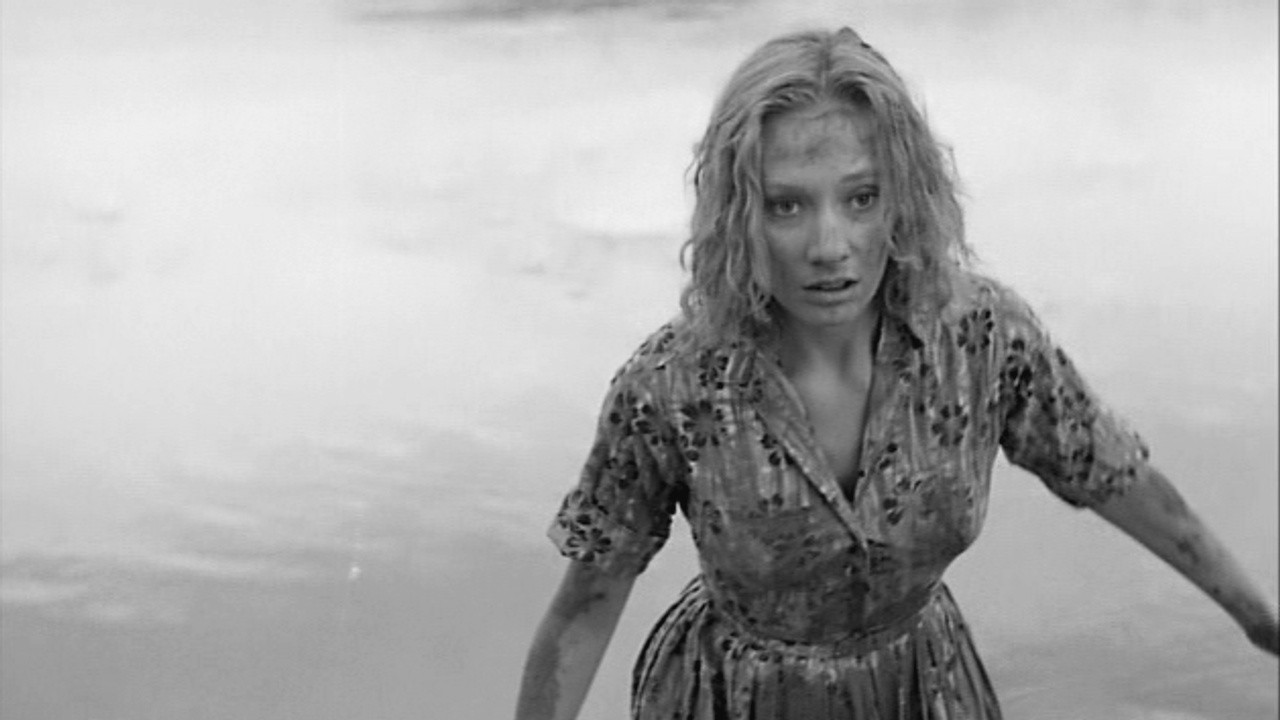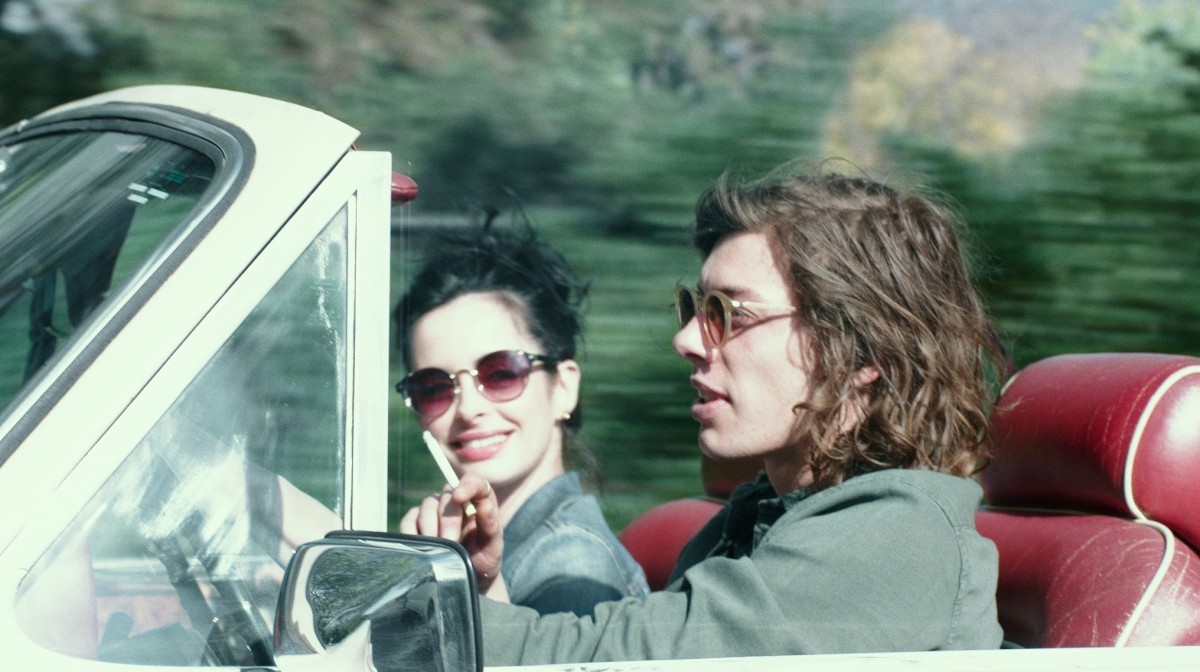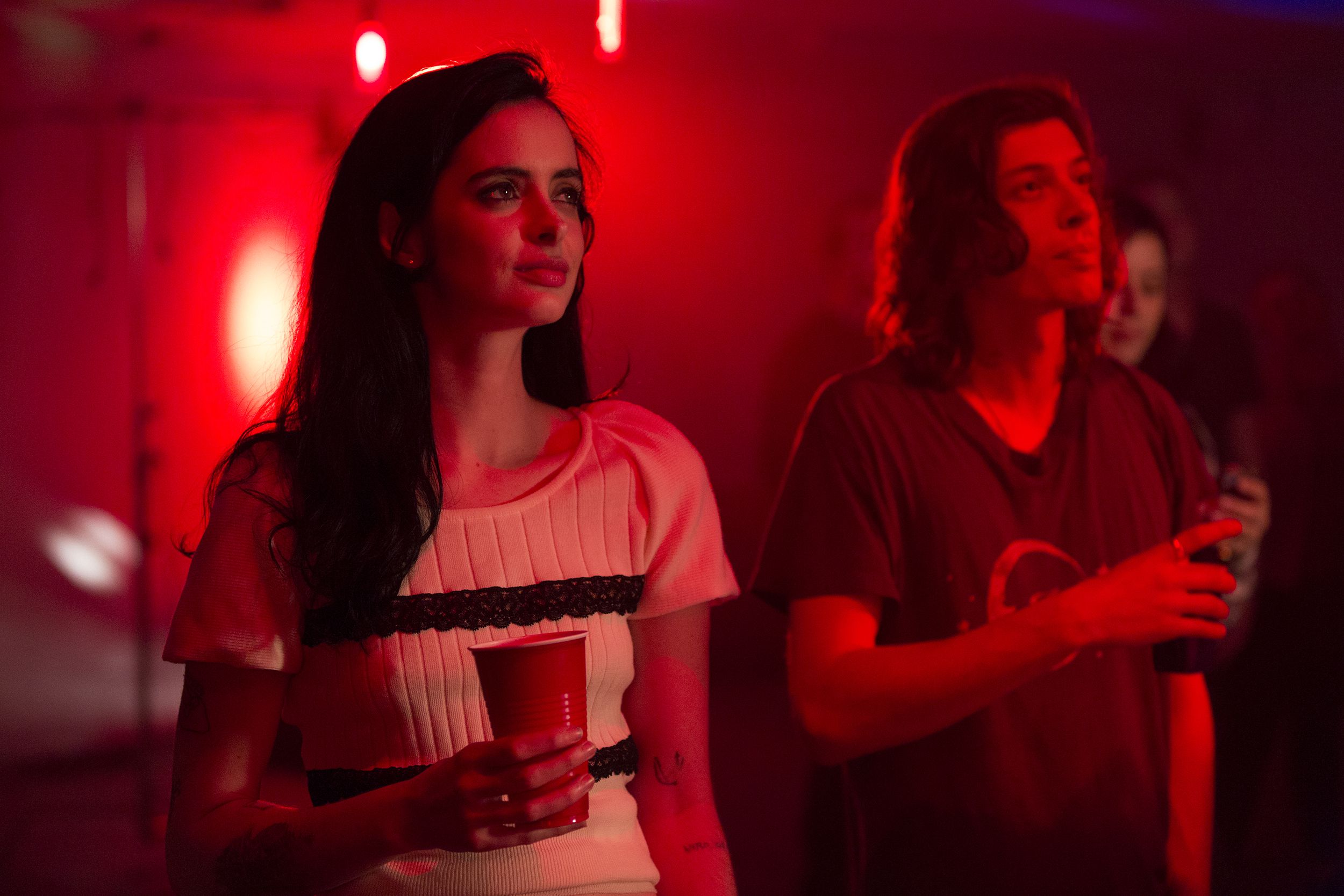This guest post written by Marlana Eck originally appeared at Awaiting Moderation. It is cross-posted with permission. | Spoilers ahead.
I’ve been watching 1962’s Carnival of Souls recurrently with rapt attention since I was a teen. My stepdad had a DVD box set which included Carnival along with The Last Man on Earth and House on Haunted Hill.
Notice the representative art work for both The Last Man on Earth and House on Haunted Hill. The Last Man on Earth, for instance, shows Vincent Price in the background with a decidedly active and intelligent glare. In the fore, we see the negative space of a woman’s spirit with her fully illustrated, sexualized body helplessly laid out on the margin credits.
In the art work for House on Haunted Hill, we see a woman in a yellow dress hanging in a noose situated in the middle of the film advertisement, and in the bottom left corner we see the severed head of a woman held by Vincent Price.
In both posters, Price is the master of his universe.
Now I love me some Vincent Price. However, looking critically, I see the limited agency of the female figures in the representative art work as a snippet of larger culture. Horror calls to mind the repressed, the subconscious. It is fascinating that the art of both of these film posters show sacrificial women. As Pierre Bourdieu sums up in “Cultural Reproduction and Social Reproduction”: structures reproduce themselves, and these posters show us how female bodies are treated within the context of our culture.
There were several promotional film posters used for Carnival of Souls, but the one on the boxed set was the commissioned illustration which showed a woman (Mary Henry as we learn, played by Candace Hilligoss) with the straps of her white top falling off (pretty sure half nipple hanging out) and leg out almost up to her hip, centered. On the left-hand bottom corner there is the “floating head” of “The Man” (as he is billed in the credits) styled after the main terrorizing apparition in Carnival, played by the film’s director, Herk Harvey.
As I go on in my interpretation, I hear a 1989 interview with the film’s writer, John Clifford, echoing in my mind. In an endearing Midwestern twang he said, “We just wanted to make a horror movie with some pizzazz.” Herk Harvey implied people have granted the film more meaning than they originally intended. I am aware, then, that perhaps the subversive tenants of the film were not intentionally engineered and may have been subliminal on the part of the creators.
The film begins with a cryptic portrayal of misogyny: a car full of men challenge a car full of women to a drag race, which was quite popular in our nation’s history post WWII as it emphasized a leisurely freedom loving and equally destructive America.
The men run the women off the road as we fear most of them have plunged to their death.
After the crash, the police question one of the men who challenged the car of women to the drag race. He lies and says “It wasn’t our fault. We were the first ones on the bridge, coming along, following the track, and they wanted to get around us I guess and they lost control and they dropped off…”
A crowd of select townspeople watch as the police fish for the missing car. This scene is riveting, if only for the audience of onlookers being 100% men, young and old.
Yet, hours later as the women’s car is exhumed, there is one woman who just won’t die: Candace Hilligoss’s character, Mary Henry. She famously trudges up from the mud, seemingly unharmed. We are unclear how long she was underwater, how she survived, or if she is even really alive (this is a horror flick, after all). It is this iconic picture that starts us off.
Mary could easily represent a critique of wartime post-traumatic stress disorder; Herk Harvey was a veteran himself opting out of the Navy and going into theater after his service in WWII.
Mary tries to resume her life, but irritates others with her insouciance.
Hilligoss trained with Lee Strasberg (in New York City where her cohort included Marilyn Monroe). Carnival of Souls was one of her only forays into film, she was mainly a stage actress. Hilligoss has a keen sense for the macabre, an edginess that I find so badass. This is part of her supposed supernaturalness.
In one of the first scenes where we learn more about Mary’s life, we observe she is a talented organist who has decided to take a job out in Utah. The priest says goodbye to her and tells her the ole, “If you’re ever in town again, stop by.” Not one for niceties, Mary says, “I don’t know if I’m ever coming back.” After she walks out the priest confides in one of his bros, “I don’t know about that girl [sic]…a few days ago she survived an accident. You’d think she’d feel a little something like humbleness or gratitude.”
A looming thought is: so, Mary is walking about “dead.” What does it mean to be a “living” woman?
What is so terribly “weird and unnatural” (to use the verbiage from one of Carnival of Soul’s promotional taglines) about Mary? The film investigates metaphysical uncertainties in the mind of this young church organist. Does she have a soul? Why doesn’t she connect with others the way she is supposed to?
Partly, I think Mary is simply a byproduct of all that was negative about the boom of consumer culture in the 1950s and 60s. The dissonance Mary displays can be attributed to the confusion of women not being as liberated as they thought they’d be by “going to work.” She is continually haunted by “The Man,” a ghoul who represents all she will become (dead, laborer).
When she spurns the advances of her voyeur housemate, John, (a classic “I’M JUST A NICE GUY!”) who frequently watches her bathing and dressing, she then deals with being “the bitch.” Interestingly, she doesn’t reject John on the basis of religious protestation (as maybe you’d think was her orientation as a church organist). She says, “The church is just a place of business.” This is quintessential Mary Henry. She tells John (essentially), “K, you have to leave now, I want to go shopping.” It is only during this time in the film do we see her look as if she is in love as she swoons. But it’s love for shopping, not John.
There are several scenes in the film where she is in public places and people don’t see her at all. She feels invisible, alienated. The ghouls, her subconscious fears, always see her though, especially “The Man.”
One of these scenes is in a department store. She goes in to try on a dress in a chipper mood. All of a sudden there are dreamy glitch squiggles on the screen and Mary snaps back into her post-accident self. She panics and runs out of the dressing room screaming that no one sees her. No one really sees her. I feel you, Mary.
Mary talks to a male analyst who tells her everything she’s been experiencing has been her imagination. Yes, she may have PTSD, but we know there is something else going on with Mary, and so does she.
The amount of mansplaining Mary has to face in this film is incredible. Candace Hilligoss’s exquisite portrayal of resistance and apathy inspires me to do Mystery Science Theater style voiceovers of key scenes. For instance her supervisor, the priest, says, “But, my dear, you cannot live in isolation from the human race,” to which Mary, in my head, responds, “WATCH ME, G.”
It’s also fun to caption her with postmodern endearments, like “Dafuq?” in the photo below.
While Harvey and Clifford may not have intended to make Mary a subversive woman, she certainly was in a few ways. Much like Jill Lepore does in The Secret History of Wonder Woman, I look at Harvey and Clifford’s work of male gaze through my female gaze. Unlike William Marston’s Wonder Woman, Mary Henry was never meant to be a hero of this story. Keep in mind, her actions and her situation are supposed to be terrifying. Only because she was presumed to be dead could she act in ways “unfit” for a woman.
Uncoupled, hardhearted, curt, and curious. Many have compared the story of Carnival of Souls to Ambrose Bierce’s short story “An Occurrence at Owl Creek Bridge” where the protagonist, Confederate soldier Farquhar, imagines the noose around his neck at his execution does not kill him and he instead escapes by swimming upstream to find his wife and children. This fantasy of being able to escape pending actions of justice is similar to Mary’s conundrum.
Mary is not able to live out her fantasy of embodying the detachment she feels as a “real life” experience. What traumas may she have faced while alive? We are introduced to a variety of scenarios, all of which many woman deal with regularly: leering, mansplaining, male-based research and psychoanalysis, accusations of “hysteria,” spiritual guilt. In the final shot of the film, we notice the car is exhumed once more, and Mary is still inside of it, dead, unable to work through her traumas as a living, insubordinate woman.
Marlana Eck is a scholar, writer, and educator from Easton, Pennsylvania. Her writing has appeared in The Chronicle of Higher Education, Raging Chicken Press,Hybrid Pedagogy, San Diego Free Press, Cultured Vultures, Lehigh Valley Vanguard, and Rag Queen Periodical. At the latter two publications she serves as director. In her free time she enjoys horticulture and overestimating the efficacy of her dance moves in the living room mirror. Follow her on Twitter at @marlanaesquire.













